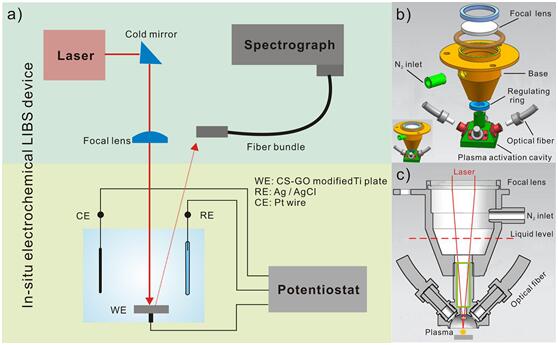In a paper published in the journal of Analytical Chemistry, the study team, jointly led by Prof. HUANG Xingjiu from Institute of Intelligent Machines, Hefei Institutes of Physical Science and Prof. ZHAO Nanjing from Anhui Institute of Optics and Fine Mechanics, Hefei Institutes of Physical Science, designed in situ underwater electrochemical laser induced breakdown spectroscopy (in situ EC-LIBS) device to detect Cr(VI) in aqueous solution.
Although Laser Induced Breakdown Spectroscopy (LIBS) has been widely applied to the determination of heavy metal ions (HMIs) in environmental samples, it always fails to directly detect HMIs in aqueous solution due to rapid quenching of emitted light and adsorption of pulse energy by surrounding water.
Aiming at this, it is carried out as a common path to transfer the aqueous samples into solid by drying on a matrix before LIBS analysis, which, however, fails to realize on-site underwater analysis.
Therefore, it is significant to find an advanced method to eliminate a series of negative effects of water on the laser for the underwater LIBS measurements.
To address this need, the team designed a gas-assisted localized liquid discharge apparatus for EC-LIBS to detect Cr(VI) in solution directly.
As for their design, an instantaneous gaseous environment was made for underwater LIBS measurements by the proposed liquid discharge apparatus, in which flowing N2 could force the solution to leak out from the laser channel and plasma activation cavity.
The preconcentration of Cr(VI) was achieved by electrosorption with a positive potential applied around adsorbents. A limit of detection (LOD) of 12.3 μg L-1 (3σ method) was achieved, which was amazingly improved by 2 or even 3 orders of magnitude compared to the previous reports of LIBS.
The last but not the least, this method has the superiorities in the analysis for any other charged ions in trace level in the solution samples compared to traditional LIBS.
This work was supported by the National High Technology Research and Development Program of China (863 Program), the National Natural Science Foundation of China and the Interdisciplinary Innovation Team of the Chinese Academy of Sciences, China.

